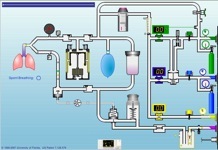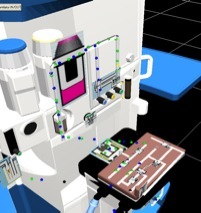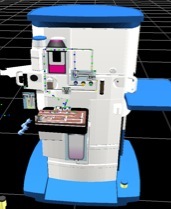
Mixed Reality for Training
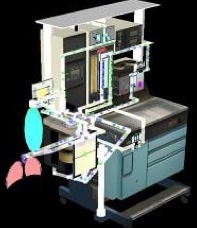
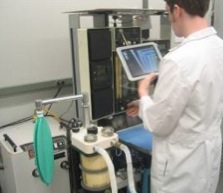
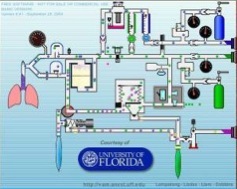
The Augmented Anesthesia Machine
Video Overview: AAM
Overview :
The Augmented Anesthesia Machine (AAM) is a Mixed Reality system that augments an anesthesia machine with an abstract simulation of the machine’s internal workings.
The AAM gives students the ability to:
1.Interact with a real anesthesia machine – i.e. turn knobs, press buttons etc.
2.Visualize an abstract simulation of the machine’s internal workings – i.e. invisible gas flow.
The combination of 1 and 2 helps students
to better understand how their interactions affect the internal
workings of the machine.
Motivation
Eighty percent of anesthesia related
operating room accidents are due to human error. These accidents occur
because the anesthesiologist does not properly check the machine before
a procedure. Then, when a fault in the machine occurs, the
anesthesiologist cannot troubleshoot the problem quickly enough to save
the patient. In order to pre-check the machine and to fix machine
faults, the anesthesiologist must have a good understanding the
internal gas flows and the relationships of the internal components of
the machine.
To address this problem, anesthesiology
educators created the now widely used Virtual Anesthesia Machine (VAM)
(figure 1 left). The VAM is an interactive, abstract 2D simulation of
the internal components and invisible gas flows of an anesthesia
machine. However, as anesthesiology experts have noted, 20% of students
still have difficulty understanding the internals in the context of the
real machine.
The Augmented Anesthesia Machine (AAM) is
a potential solution to this problem. The AAM uses Mixed Reality (MR)
technology such as optical tracking systems and a magic lens to combine
the VAM and the real anesthesia machine. Then students can interact
with the real anesthesia machine and visualize how these interactions
affect the internal components and invisible gas flow. The AAM
facilitates new strides in the traditionally disparate fields of
simulation, psychology, and anesthesiology education by using MR to
effectively combine an anesthesia machine with its corresponding
abstract simulation.
The Augmented Apollo:
Presented at the American Society of Anesthesiologists Conference 2008
Publications
Quarles, J., S. Lampotang, I. Fischler, P. Fishwick, B.Lok "Scaffolded Learning with Mixed Reality" (accepted 2008) Journal of Computers and Graphics: Special Issue on VR.
Team Members
The AAM project is multidisciplinary project including researchers from the following fields:
HCI / Mixed Reality
John Quarles, Assistant Professor, UTSA CS
Benjamin Lok, Assistant Professor,UF CISE
Modeling and Simulation
Paul Fishwick, Professor, UF CISE
Anesthesiology
Samsun Lampotang, Professor, UF Dept of Anesthesiology
Psychology
Ira Fischler, Professor, UF Dept of Psychology
For more information, contact: John Quarles - jpq@cs.utsa.edu
Left: the Virtual Anesthesia Machine – a widely used abstract simulation of an anesthesia machine. middle: the Augmented Anesthesia Machine Simulation right: A student uses the magic lens to visualize the simulation from a first person perspective.
We all live in a world full of black boxes. That is, we all understand how to interact with objects around us (e.g. an ATM machine, a car), but most people do not understand how these objects operate internally. However, in many cases this understanding is vital, such as in medical training and practice (e.g. understanding medical devices or the human body). To address this problem, researchers engineered a novel approach that can render these black boxes transparent and improve overall understanding of the world around us. This research uses mixed reality to combine abstract simulations with the corresponding physical objects.
